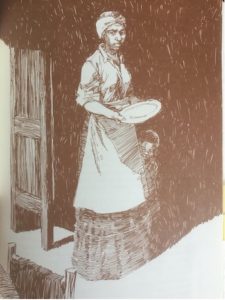
Silvia Hector Webber
*Silvia Webber's birth is celebrated on this date, c. 1807. She was an enslaved Black woman and abolitionist.
Born Sylvia Hector, she was from the Spanish West Florida parishes that became part of eastern Louisiana. There are few records of her childhood except a bill of sale on March 10, 1819. The twelve-year-old Hector was sold to Morgan Cryer, Sr., of Clark County, Arkansas, by his son-in-law, Silas McDaniel, of Clark County, Missouri, for $550. The Cryer family lived on a plantation in South Carolina and migrated to Georgia, Spanish West Florida, Arkansas, and Missouri Territory in 1815. Her life in Arkansas was not documented.
Records suggest that Silvia Hector came to Texas as enslaved property of Cryer when she was nineteen. According to Hector's emancipation papers and several accounts, she met John Ferdinand Webber, a business partner of Cryer, between 1826 and 1829, and he “became infatuated with her.” Hector and Webber’s first child, Alcy, was born in October 1829. She and her family lived in Austin’s Little Colony on the 2,214.2-acre land grant her husband secured on July 22, 1832, on the Colorado River near the Travis-Bastrop County line. In that isolated location, Silvia and John established their ranch on what became known as Webber’s Prairie.
She was likely the first free Black settler and founder of that area, which developed as early as 1826. A few years later, she helped her husband establish the town of Webber’s Prairie on the Colorado River, approximately fifteen miles southeast of Austin. By 1834, while still enslaved, Silvia had given birth to two sons, Henry Webber and John Webber.
On June 11, 1834, John Webber and Silvia purchased her freedom and their three children. According to witness accounts, Cryer, “cognizant of the situation, took advantage of it to drive a sharp bargain” when Silvia and John made their request. Cryer required payment to secure Silvia and the Webber children’s freedom, but not in money or specie. Webber agreed to deliver a two-year-old enslaved boy to John Cryer and a three-year-old enslaved girl to Polly Odum, likely Cryer’s niece, before the final day of October 1834. Enslaved children were valuable for any Texas slaveholder.
After her freedom was finalized, she and John F. Webber lived as husband and wife. It is unclear when they married; however, oral histories given by their descendants state that Silvia and John were wed by a Catholic priest named Father Michael Muldoon. Although interracial marriage was legal under Mexican law in 1834, Texas frowned upon it. They had thirteen children. She was smart, kind, and welcoming and became known as “Aunt Puss” Webber by her neighbors in Webber’s Prairie. She was a woman well-liked for her charity to all those who needed help, even when laws in the state limited her rights, mobility, and daily life as a free Black woman in antebellum Texas.
According to some accounts, the family helped the needy and Blacks who sought asylum. Her house was “always open to anyone, and no human being ever went away from its doors hungry.” After living at Webber’s Prairie for approximately twenty years, Silvia, her husband, and their children left Travis County. Seeking to escape racial discrimination, the “strong prejudice against free Blacks,” and increased animosity and attacks the family faced, the Webbers sold their land in Central Texas and moved south in 1851. The town’s name changed to Webberville in 1853. In 1853, they purchased 8,856 acres in a region known as the Porción Agostadero del Gato, six miles east of Hidalgo, near the U.S.-Mexican border. They established another successful ranch near San Juan and slightly south of Donna.
In South Texas, she and her husband rebuilt their lives. They established the Webber Ranch on land wedged between the Donna water pump in Hidalgo County and the old military highway that neighbored the ranch of Matilda and Nathaniel Jackson, another interracial couple known that helped fugitive slaves and asylum seekers. Family descendants and South Texas lore tell of Silvia’s role in helping many a runaway slave find refuge on the Webber’s ranch and how she often utilized her home as a stop on the rumored Underground Railroad that led south into Mexico. Silvia and John built a ferry landing at the Webber Ranch and licensed a ferry stop that led directly from their home on the Rio Grande to Mexican waters.

Their construction was useful for their trading business and to facilitate helping fugitives from slavery reach freedom in Mexico. Silvia Webber was a staunch anti-slavery advocate, and throughout the Civil War, she and her family stood against the Confederacy. When Confederate troops occupied Hidalgo County, Silvia’s family was persecuted for being “Union sympathizers” and quickly driven off their ranch. The family moved to Mexico then and did not return to Texas or the Webber Ranch until 1882. Her husband died soon after in 1882. Silvia lived on her ranch until her death on September 13, 1892. She is buried near her husband and descendants at the Webber Cemetery in Hidalgo County.